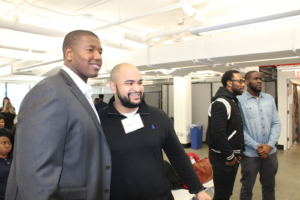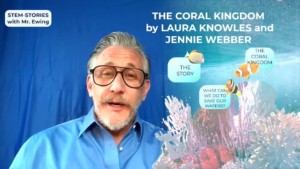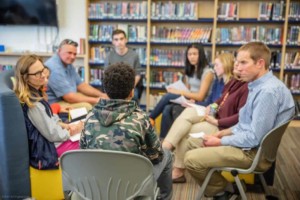How One Teacher is Teaching Her Students to be Kind

Kindness is a relatively easy word to define–according to Google it means “the quality of being friendly, generous and considerate.” Easy enough, right? Then why is “kindness” often so hard to put into practice? How do we go about teaching and learning kindness? I recently spoke with Stacy Weber, a fifth-grade teacher in a dual language program in Woodstock, Illinois, to shed some light on this and understand how she’s teaching kindness.
Kindness Weeks
Recently there have been kindness movements happening throughout the country designed for educators and everyday citizens, with one goal in mind: spreading the message and act of being kind. Stacy’s class participates in two such events.
Great Kindness Challenge
The first is the Great Kindness Challenge, which this year took place January 22-28th, and which is designed for participation by schools and families to empower students to create a culture of kindness. In 2017, over 10 million students at over 15,000 schools in 90 countries completed over 500 million acts of kindness. Stacy incorporated the #GreatKindnessChallenge into her own classroom by working with her students and her partner teacher Kathe Lacey-Anderson, to perform as many random acts of kindness as possible. It was a schoolwide event, and each classroom kept track of their acts of kindness.
While the official Kindness Challenge week has ended, it’s never truly over. Stacy recommends checking out the school checklists which outline kindness challenges and acts of kindness, along with ClassDojo and Harvard University’s Making Caring Common Project videos and lessons on empathy. In Stacy’s classroom, she has structured weekly lessons using the Second Step curriculum. She explains, “the fifth-grade focus is empathy. Students are learning what empathy is and how they can show empathy towards others. It’s tough to understand how someone else is feeling if you haven’t thought about it and practiced it. Thanks to Second Step, we practice it every week!” Stacy has found that the ClassDojo-Harvard videos are “an engaging way to introduce tricky ideas to students. The empathy video and lesson ideas are easily integrated into our Second Step lessons.”

Random Acts of Kindness Week
Stacy’s class also participates in the Random Act of Kindness Week which takes place February 11-17th. The Random Act of Kindness Foundation is behind RAK Week and believes in the “power of kindness to change the way people see and experience the world.” They have designed educator resources to help teach kindness and can be used during #RAKWeek2018 and beyond. The lessons that are featured are standards aligned and teach social and emotional learning (SEL) skills. While Stacy is still working on her plans for RAK Week, one thing she hopes to incorporate is for her students to record videos for their new penpals in Nigeria. This school year through a service project, Stacy’s class has been collecting donations for a school in Nigeria (they’re using GoFundMe). In addition, she said, “we are now sending videos back and forth with Nigerian students and we love practicing our kindness as we get to know them!”

Kindness is Year Round
For Stacy, “teaching and spreading kindness is how we connect with people” so it’s no wonder that each day she encourages and reminds her students to be kind. She shared, “it is much too easy to get so involved with your own life that you can’t see what’s around you. I try to incorporate acts of kindness throughout our lessons and the “teachable moments” that are not necessarily part of the lesson plan.” For example, in a recent literacy unit on real-life superheroes her class had many discussions about the acts of kindness that those superheroes performed and how much they changed the world for the better because of one act.
Stacy is finding that her students are excited to be kind and even share the kind things with her that they did over the weekend. She is also noticing a shift in their mindsets since a focus area this year has been developing a growth mindset –“I can” versus “I can’t”. The school’s theme this year is “The Power of Yet”, “I can’t do it…YET.” She points out, “that one word is powerful. This relates back to kindness in my classroom because I also want my students to be kind to themselves. It is sometimes easier to be kind to others than to realize you need a little kindness yourself. Having a growth mindset allows you to be patient, understanding, and ultimately, kind to yourself. We have a challenging curriculum and social issues start to brew more in fifth grade; being kind to both other people and yourself is necessary in order to work through any of that.”
Teaching Kindness in Your Own Classroom

I asked Stacy what advice she would give other educators she responded, “My advice to educators who want to incorporate kindness into their teaching and learning is to be like Nike and ‘just do it.’ I had no solid plan for teaching and focusing on kindness this year. I saw the need for it as I heard my students talking and watched how they treated each other. I searched online for some ideas, found one that sounded fun and effective and had it ready to go the next day. It doesn’t have to be an official, on-the-curriculum-plan-since-August type of thing. If you want to do it, make it happen. My other piece of advice is to find someone to help you out, even as just a sounding board. My teaching partner, Kathe, teaches the same students I do and sees the same behaviors and attitudes that I do. She has been an invaluable resource, confidante and collaborator. We do not run our classrooms the same, but we support each other in what the other is doing.”
In addition to the ClassDojo-Harvard videos, Stacy also mentioned a couple of other resources that she’s found very helpful:
- Ferial Pearson’s “Secret Kindness Agents: How Small Acts of Kindness Can Really Change the World”. Using this book Stacy designed an activity where students received a top secret envelope with a Secret Agent ID badge, a kindness journal and a list of RAK ideas. She said, “their favorite part, aside from the actual acts, was choosing their Secret Agent name! My favorite part was the kindness journal, where students reflected on the acts of kindness they performed. I think it was eye-opening for them to realize that being kind not only helps someone else feel good but also makes YOU feel good!” She found this printable kit helped bring the activity to life.
- During the holiday season, she used a community building activity to help her students celebrate kindness.
Like Stacy, I think the best way to often start something is to “just do it.” With the start of Random Acts of Kindness Week, there’s no better time to think of ways to teach kindness within your classroom. Share your ideas of how your teaching kindness in the comments below, and join the kindness conversations at #RAKWeek2018 and #GreatKindnessChallenge.
For more, see:
- Global Dignity for a Better Tomorrow
- Random Acts of Kindness Week: High Tech Meets High Touch
- 10 Great Apps to Promote Kindness in the Classroom
Stay in-the-know with all things EdTech and innovations in learning by signing up to receive the weekly Smart Update.







0 Comments
Leave a Comment
Your email address will not be published. All fields are required.